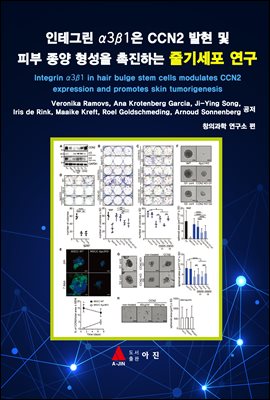
인테그린 α3β1은 CCN2 발현 및 피부 종양 형성을 촉진하는 줄기세포 연구
- 저자Veronika Ramovs, Ana Krotenberg Garcia, Ji-Ying Song, Iris de Rink, Maaike Kreft, Roel Go
- 출판사아진
- 출판일2020-07-12
- 등록일2020-12-21
- SNS공유


- 파일포맷PDF
- 파일크기20MB
- 공급사YES24
-
지원기기
PC
PHONE
TABLET
프로그램 수동설치
전자책 프로그램 수동설치 안내
아이폰, 아이패드, 안드로이드폰, 태블릿,
보유 1, 대출 0,
예약 0, 누적대출 5, 누적예약 0
책소개
Epidermal-specific deletion of integrin α3β1 almost completely prevents the formation ofpapillomas during 7,12-Dimethylbenz [a]anthracene/12-O-tetradecanoylphorbol-13-acetate
(DMBA/TPA) two-stage skin carcinogenesis. This dramatic decrease in tumorigenesis was
thought to be due to an egress and premature differentiation of α3β1-depleted hair bulge
(HB) stem cells (SCs), previously considered to be the cancer cells-of-origin in the DMBA/
TPA model. Using a reporter mouse line with inducible deletion of α3β1 in HBs, we show
that HB SCs remain confined to their niche regardless of the presence of α3β1 and are
largely absent fromskin tumors. However, tumor formation was significantly decreased in
mice deficient for α3β1 in HB SCs. RNA sequencing of HB SCs isolated from short-term
DMBA/TPA?treated skin showed α3β1- dependent expression of the matricellular protein
connective tissue growth factor (CCN2), which was confirmed in vitro, where CCN2
promoted colony formation and 3D growth of transformed keratinocytes. Together, these
findings show that HBs contribute to skin tumorigenesis in an α3β1-dependent manner
and suggest a role of HB SCs in creating a permissive environment for tumor growth
through the modulation of CCN2 secretion.
목차
제 1편 코로나바이러스 정의1. 코로나바이러스감염증-19(Covid-19) 정보 7
2. 코로나바이러스 분류 및 특성 9
3. 코로나바이러스 전자현미경 형태 11
4. 코로나바이러스 구조 (Covid-19 Organization) 13
5. 코로나19: 환경에 지속적인 영향을 미칠까? 19
6. 치료법(Therapeutical Method) 22
제 2편 연구논문
Integrin α3β1 in hair bulge stem cells modulates CCN2
expression and promotes skin tumorigenesis
1. Introduction 23
2. Results 24
3. Discussion 29
4. Materials and Methods 33
5. Animal experiments 34
6. Cell culture 35
7. Data Availability 36
8. References 36

















